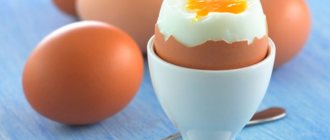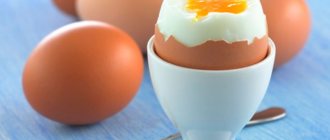If we consider the diets of dietary, sports, fasting and so-called proper nutrition, we can note one common feature. The menu always includes egg dishes. In this regard, the question often arises of how many calories are in scrambled eggs cooked with different ingredients. The nutritional value and calorie content of scrambled eggs are the main indicators discussed in this article.
Scrambled eggs with tomatoes, cheese or chicken are considered the ideal breakfast in the morning. It is an excellent alternative to diet sandwiches. Those who play sports often use this high-protein dish not only in the morning, but also at other times, especially before and after training. And it’s even more difficult to imagine an egg diet without this healthy dish.
Nutritional value of chicken eggs
The chemical composition of eggs allows them to be classified as dietary protein products. In terms of amino acid composition, egg white is much better balanced than any other. The Food and Agriculture Organization of the United Nations has long accepted it as a standard for assessing the biological value of other proteins. And now many experts continue to use this animal product as a “template” for comparison.
The nutritional value of a boiled egg is determined by the amount and ratio of proteins, fats and carbohydrates. These data directly determine the energy value of boiled and fried chicken eggs. It should be noted that the main share of nutrients that determine calorie content is concentrated in the yolk. How much BJU is in an egg and what else does it contain?
Other biologically important compounds (vitamins, mineral salts) do not affect calorie content, but determine the usefulness of the dish. Fried eggs, scrambled eggs, as well as omelette, thanks to very fast cooking, retain all biologically important substances.
How many proteins are in an egg
The amount of protein in egg products (chicken) is 12.9% (or 12.9 g in every 100 g) of the total amount of all compounds, including water. Proteins contain eight essential amino acids, which determine their high nutritional value. For reference, essential amino acids are those that the human body cannot synthesize on its own and must receive them from food. The essential amino acids involved in the construction of egg proteins include:
- valine
- isoleucine
- leucine
- lysine
- methionine
- threonine
- tryptophan
- phenylalanine
Even one egg eaten for breakfast or lunch can cover 14% of the body's daily protein needs. Moreover, it is a complete protein, that is, containing both essential and essential amino acids.
How much fat is in an egg
The lipid complex of this product is quite unique. It contains a large proportion of cholesterol (0.57%), but at the same time there is a lot of phospholipids (3.39%), which to some extent neutralizes the negative (atherogenic) effects of cholesterol.
In particular, lecithin and choline make up a large proportion. They prevent the negative effects of cholesterol from manifesting themselves. If we compare the ratio of lecithin to cholesterol in this chicken product, it is clearly in favor of the former - 5-8:1. Therefore, you can eat scrambled eggs calmly, without fear for your blood vessels.
In general, a chicken egg contains 20.9% fat of the total amount of all substances. The largest proportion, in addition to the phospholipids and cholesterol already noted, are triglycerides (7.05%), saturated (3.04%), monounsaturated (4.97%) and polyunsaturated (1.26%) fatty acids.
How many carbohydrates are in an egg?
This component is the minimum - 0.9 g per 100 g of product. Considering that one specimen, even of the highest category, weighs less than 100 g, the amount of carbohydrates in it is insignificant. For this reason, these chicken (and quail) products are often included in the menu of low-carbohydrate and protein diets.
Read on the My Figure website:
Calories, glycemic index of peanut butter
Does split meals help you lose weight?
How many grams are in 1 egg?
Egg weight ranges from 35 to 75 grams. The average weight of a chicken egg is 50-55 grams.
Interesting materials:
How to choose a lamp for plants? How to protect plants from spring frosts? How to protect plants from frost? What root system is typical for dicotyledonous plants? What are the benefits of ash for plants? What color temperature is best for plants? What color temperature is needed for aquarium plants? What types of fertilizers are there for plants? What ornamental plants can be planted in the shade? What factors influence plant growth?
Calorie content of scrambled eggs
Knowing the energy value of BJU and the amount of nutrients in chicken yolk and white, it is easy to calculate how many calories are in scrambled eggs. It is immediately worth noting that different nutritional sources give different calorie figures for scrambled eggs. It all depends on what unit of product the data is for (100 g or the number of eggs), as well as what additional products are used to prepare the dish.
According to the reference book “Everything about food from a chemist’s point of view” (authors: I.M. Skurikhin, A.P. Nechaev), fried eggs have an energy value of 243 kcal/100 g . For comparison, one soft-boiled egg has a calorie content of 159 kcal/100 g. Knowing how much a chicken egg weighs, it is easy to calculate how many calories are in scrambled eggs from 1, 2, 3, 4 or 5 pieces. But the thing is that products of different categories weigh differently:
- Third category (3) – 35.0 – 44.9 g
- Second category (2) – 45.0 – 54.9 g
- First category (1) – 55.0 – 64.9 g
- Select category (0) – 65.0 – 74.9
- Highest category (B) – from 75 g
The calorie content of scrambled eggs from 1 egg can be:
- 97 kcal (3 cat.)
- 122 kcal (2 cat.)
- 146 kcal (1 cat.)
- 170 kcal (0 cat.)
- 182 kcal (in cat.)
The calorie content of scrambled eggs from 2 eggs can be:
- 194 kcal (3 cat.)
- 244 kcal (2 cat.)
- 292 kcal (1 cat.)
- 340 kcal (0 cat.)
- 364 kcal (in cat.)
The calorie content of a scrambled egg from 3 eggs can be:
- 291 kcal (3 cat.)
- 366 kcal (2 cat.)
- 438 kcal (1 cat.)
- 510 kcal (0 cat.)
- 546 kcal (in cat.)
How many calories are in fried eggs without oil?
One fried egg contains about 7 g of fat, both in the yolk and white. Each gram of fat contains 9 calories
, so a fried egg contains 63
calories
from fat. ... Calorie content of a fried egg:
| Eggs with butter | Calorie content (Kcal) |
| 1 very large | 101 |
| 1 cup | 264 |
| Eggs without butter | Calorie content (Kcal) |
| 1 small | 55 |
Calorie content of scrambled eggs with butter, tomatoes, cheese, bacon, onions
Of course, the total energy value of fried eggs depends on what components are added to the recipe. When adding more high-calorie foods (sausages, sausages, cheese, bread), this figure increases. If a dish is fried with vegetables (tomatoes, onions, zucchini, peppers), then its calorie content becomes lower.
For example, how many calories are in fried eggs with tomatoes and cheese? Let's look at the example of a classic recipe. It includes:
- Eggs (chicken) – 4 pcs.
- Tomatoes – 100 g
- Hard cheese – 40 g
- Butter – 5 g
It turns out that the calorie content of scrambled eggs from 4 eggs, tomatoes and cheese is: 159 x 4 pcs +20 + 146 + 37 = 839 kcal. Considering that the entire dish weighs approximately 380 g, its energy value per 100 g is 220 kcal.
To reduce the calorie content of fried eggs or scrambled eggs and make the dish more dietary, you should fry without oil or lard and avoid high-calorie additives. But in this case, scrambled eggs should be cooked in a non-stick frying pan, in the microwave or baked in the oven.
Heat treatment method and weight
100 grams of raw eggs contain 160 kcal, but this product is consumed in units. Therefore, a reasonable question arises: how many grams are in one egg? The weight of one chicken egg is in the range of 45–75 g, up to 10% of which is the shell. As a rule, butter or vegetable oil is used for fried eggs, and only a few prefer to cook in a dry frying pan. A study by American scientists showed that the energy value of a medium-sized fried egg is approximately 120 kcal. To compare:
- raw - 60 kcal;
- hard boiled - 50 kcal;
- soft-boiled - 70 kcal.
The most high-calorie component of an egg is the yolk. It has about 7 times the calories of protein. If 100 g of yolk is 350 kcal, then the same amount of protein is 50. This is due to the lack of fat in the protein, as well as less carbohydrates. For clarity:
| Component name | Protein | Yolk |
| Squirrels | 10,6 | 5,7 |
| Fats | 0 | 30,9 |
| carbohydrates | 1 | 1,8 |
Therefore, it is healthier and safer to eat egg whites.
How to check egg quality
You should eat only fresh eggs , because stale eggs not only do not benefit the body, but can also cause poisoning.
You can determine the approximate freshness of an egg using a glass of water. Dip the egg into it and see how it behaves:
- It lay on the bottom in a horizontal position - it was demolished recently.
- It sank to the bottom at an angle - the egg was about a week old.
- It was installed in a vertical position - it was about 2-3 weeks old.
You can also pay attention to the surface of the shell. In fresh eggs it is clean and slightly shiny, but in stale eggs it is matte, yellowish or grayish in color.
The most useful scrambled egg recipes
In order for breakfast to be not only tasty, but also healthy and contain a reasonable amount of calories, it is recommended to cook scrambled eggs without butter. Among other things, this will not only reduce calorie content, but also reduce the amount of carcinogens you get from food. After all, it is known that these poisons are produced precisely when vegetable oil is heated. But if you don’t have the opportunity to fry in a frying pan without oil, try to minimize the amount.
The healthiest version of scrambled eggs is considered to be fried eggs with minimal addition of salt, which is eaten with toast.
Another “healthy” version of this dish is prepared with the addition of herbs and vegetables. You can add dill, tomatoes, spinach, cilantro, and herbal seasonings without salt to scrambled eggs. Its calorie content will not exceed 150-160 kcal.
When cooking, you can use an oven and silicone molds instead of a frying pan. Bake scrambled eggs for 10-15 minutes at 180 degrees. In this case, you definitely won’t need oil, the dish will be low-fat and will contain a minimum amount of calories. At the same time, all nutritional and beneficial elements will be preserved.
Also, people who need to consume a large amount of proteins and not exceed the permissible dose of cholesterol can prepare vegetable scrambled eggs only from proteins, having first removed the yolks. This recipe is suitable, for example, for athletes who want to build muscle mass.
Of course, the taste and nutritional value of a dish without yolks will suffer slightly, but on the other hand, when cooking, you can add lean boiled chicken breast or red fish meat, asparagus, spinach to the proteins, and use low-fat sauces. These scrambled eggs will be an excellent and healthy source of protein with minimal harmful additives in the form of saturated fat or cholesterol.
Composition and benefits of eggs
Eggs themselves are quite a dietary product.
They are always included in the diet of athletes who want to increase muscle mass, and serve as an excellent source of high-quality protein. But nutritionists advise consuming them in very moderate quantities. After all, the yolk of eggs contains a lot of fats, which are a source of bad cholesterol. In fact, the calorie content of scrambled eggs is the calorie content of egg yolks, since they contain up to 90% of all the nutrients that make up this product.
At the same time, you should not completely give up eating eggs. After all, they are an irreplaceable source of many amino acids, proteins, polyunsaturated fats (including oleic) and fatty acids (linoleic and linolenic). In addition to cholesterol, the yolk is a storehouse of useful vitamins.
It contains a lot of vitamin A, E, one of the largest amounts of vitamin D, almost all B vitamins (B6, B12, B1, B7, B3, B5). Yolk also has the highest content of choline (vitamin B4) of all foods, which helps remove cholesterol and protects cell membranes from the effects of free radicals.
It is worth noting that this product, especially its shell, is an excellent source of calcium. In addition, it contains a lot of iron, copper, phosphorus, iodine and a certain amount of such a rare trace element as cobalt.
Eggs are almost completely absorbed by the body. This is good from the point of view of their nutritional value, but when including this product in your diet, you should pay attention to their calorie content, especially if you are on a diet, since 100 grams of eggs (the equivalent of two pieces) contain on average about 150 kcal.











